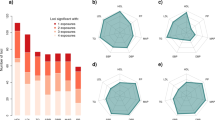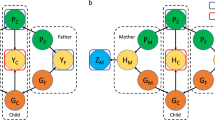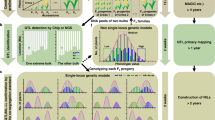Abstract
THE distribution of genotypes q2aa+2qpaA+p2AA, commonly called the Hardy–Weinberg law, has been recognised at least since 1908. It gives the frequencies of genotypes in a randomly mating population with respect to a single locus maintaining two alleles a and A with respective frequencies q and p. A generalisation given in 1922 by Wright and discussed in his book1 gives the distribution  where F, the “fixation index” is the correlation between pairs of gametes uniting to form zygotes.
where F, the “fixation index” is the correlation between pairs of gametes uniting to form zygotes.
This is a preview of subscription content, access via your institution
Access options
Subscribe to this journal
Receive 51 print issues and online access
$199.00 per year
only $3.90 per issue
Buy this article
- Purchase on SpringerLink
- Instant access to full article PDF
Prices may be subject to local taxes which are calculated during checkout
Similar content being viewed by others
References
Wright, S., Evolution and the Genetics of Populations, 2, 174 (University of Chicago Press, Chicago, 1969).
Fisher, R. A., Trans. R. Soc. Edinb., 52, 399–433 (1918).
Malécot, G., thesis, Univ. Paris (1939).
Malécot, G., C.r. hebd. Séanc. Acad. Sci. Paris, 226, 1682–1683 (1948).
Author information
Authors and Affiliations
Rights and permissions
About this article
Cite this article
STARK, A. Generalisation of the Hardy–Weinberg law. Nature 259, 44 (1976). https://doi.org/10.1038/259044a0
Received:
Accepted:
Issue date:
DOI: https://doi.org/10.1038/259044a0



